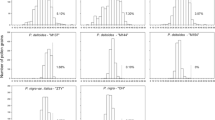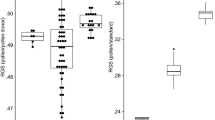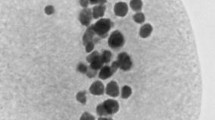Abstract
Reproductive variation was studied in the tetraploid Pilosella aurantiaca, hexaploid P. rubra (both species with facultative autonomous apospory) and in their 2n + n hybrids, which were obtained by crossing with a sexual pollen parent (tetraploid P. officinarum). The different DNA content in P. aurantiaca and P. officinarum demonstrated the actual 2n + n origin, both spontaneous from the field and through experimental crosses, of their hexaploid hybrids. The octoploid 2n + n progeny were recovered from an experimental cross of P. rubra and P. officinarum. The reproductive pathways operating in two maternal facultatively apomictic species and in the hybrids were quantified using a flow cytometric analysis of seeds obtained from either open-pollinated or emasculated plants. Whereas both maternal species displayed a high penetrance of apomixis, the level of apomixis among the majority of 2n + n hybrids was much lower and variable. Some of the hexaploid hybrids had a reduced seed set. Compared to the respective maternal parents, the decrease in apomixis due to haploid parthenogenesis and/or n + n mating was evident in almost all unreduced hybrids, irrespective of their field/experimental origin and ploidy. Hence, the reproductive behaviour in the apomictic maternal parent was profoundly different from that of the 2n + n hybrids with a sexual parent in spite of the preservation of the complete maternal genome in the hybrids. The regulatory interactions in hybrid genomes, such as effects of modifiers, heterochrony, and epigenetic control, may be consistent with the different expressivity of apomixis observed under different genetic backgrounds.



Similar content being viewed by others
References
Albertini E, Marconi G, Barcaccia G, Raggi L, Falcinelli M (2004) Isolation of candidate genes for apomixis in Poa pratensis L. Plant Mol Biol 56:879–894
Barcaccia G, Arzenton F, Sharbel TF, Varotto S, Parrini P, Lucchini M (2006) Genetic diversity and reproductive biology in ecotypes of the facultative apomict Hypericum perforatum L. Heredity 96:322–334
Batygina TB (ed) (2009) Embryology of flowering plants. Terminology and concepts. Vol. 3 Reproductive systems. Science Publishers, Enfield
Bicknell RA, Koltunow AM (2004) Understanding apomixis: recent advances and remaining conundrums. Plant Cell 16:228–245
Bicknell RA, Borst NK, Koltunow AM (2000) Monogenic inheritance of apomixis in two Hieracium species with distinct developmental mechanisms. Heredity 84:228–237
Bicknell RA, Lambie SC, Butler RC (2003) Quantification of progeny classes in two facultatively apomictic accessions of Hieracium. Hereditas 138:11–20
Bräutigam S, Greuter W (2007) A new treatment of Pilosella for the Euro-Mediterranean flora. Willdenowia 37:23–137
Burson BL, Hussey MA, Actkinson JM, Shafer GS (2002) Effect of pollination time on the frequency of 2n + n fertilization in apomictic buffelgrass. Crop Sci 42:1075–1080
Carman JG (1997) Asynchronous expression of duplicate genes in angiosperms may cause apomixis, bispory, tetraspory, and polyembryony. Biol J Linn Soc London 61:51–94
Catanach AS, Erasmuson SK, Podivinsky E, Jordan BR, Bicknell R (2006) Deletion mapping of genetic regions associated with apomixis in Hieracium. Proc Natl Acad Sci USA 103:18650–18655
Chapman H, Bicknell R (2000) Recovery of a sexual and an apomictic hybrid from crosses between the facultative apomicts Hieracium caespitosum and H. praealtum. N Z J Ecol 24:81–85
Curtis MD, Grossniklaus U (2007) Amphimixis and apomixis: two sides of the same coin. In: Hörandl E, Grossniklaus U, Van Dijk PJ, Sharbel TF (eds) Apomixis: evolution, mechanisms and perspectives, Regnum Veg 147. A.R.G. Gantner Verlag, Rugell, pp 37–62
Dresselhaus T, Carman JG, Savidan Y (2001) Genetic engineering of apomixis in sexual crops: a critical assessment of the apomixis technology. In: Savidan Y, Carman JG, Dresselhaus T (eds) The flowering of apomixis: from mechanisms to genetic engineering. CIMMYT, IRD, European Commission DG VI (FAIR), Mexico, D.F., pp 229–243
Fehrer J, Šimek R, Krahulcová A, Krahulec F, Chrtek J, Bräutigam E, Bräutigam S (2005) Evolution, hybridisation, and clonal distribution of apo- and amphimictic species of Hieracium subgen. Pilosella (Asteraceae, Lactuceae) in a Central European mountain range. In: Bakker T, Chatrou LW, Gravendeel B, Pelser PB (eds) Plant species-level systematics: new perspectives on pattern and process, Regnum Veg 143. A.R.G. Gantner Verlag, Rugell, pp 175–201
Fehrer J, Krahulcová A, Krahulec F, Chrtek J Jr, Rosenbaumová R, Bräutigam S (2007) Evolutionary aspects in Hieracium subgenus Pilosella. In: Hörandl E, Grossniklaus U, Van Dijk PJ, Sharbel TF (eds) Apomixis: evolution, mechanisms and perspectives, Regnum Veg 147. A.R.G. Gantner Verlag, Rugell, pp 359–390
Fitze D, Fehrer J (2000) PCR-RFLP studies of non-coding chloroplast DNA in European Hieracium subgen Pilosella. Abh Ber Naturkundemus Görlitz 72(suppl.):4
Gadella TWJ (1987) Sexual tetraploid and apomictic pentaploid populations of Hieracium pilosella (Compositae). Plant Syst Evol 157:219–245
Gadella TWJ (1988) Some notes on the origin of polyploidy in Hieracium pilosella aggr. Acta Bot Neerl 37:515–522
Gottschlich G, Raabe U (1991) Zur Verbreitung, Ökologie und Taxonomie der Gattung Hieracium L. (Compositae) in Westfalen und angrenzenden Gebieten. Abh Westfäl Mus Naturkd 53:3–140
Grimanelli D, Leblanc O, Perotti E, Grossniklaus U (2001) Developmental genetics of gametophytic apomixis. Trends Genet 17:597–604
Grimanelli D, García M, Kaszas E, Perotti E, Leblanc O (2003) Heterochronic expression of sexual reproductive programs during apomictic development in Tripsacum. Genetics 165:1521–1531
Harlan JR, De Wet JMJ (1975) On Ö. Winge and a prayer: the origins of polyploidy. Bot Rev (Lancaster) 41:361–390
Hörandl E, Grossniklaus U, Van Dijk PJ, Sharbel TF (eds) (2007) Apomixis. Evolution, mechanisms and perspectives, Regnum Veg 147. A.R.G. Gantner Verlag, Rugell
Houliston GJ, Chapman HM (2001) Sexual reproduction in field populations of the facultative apomict, Hieracium pilosella. N Z J Bot 39:141–146
Houliston GJ, Chapman HM, Bicknell RA (2006) The influence of genotype and environment on the fecundity and facultative expression of apomixis in Hieracium pilosella. Folia Geobot 41:165–181
Johri BM, Srivastava PS (eds) (2001) Reproductive biology of plants. Springer and Narosa Publishing House, Berlin
Kaushal P, Malaviya DR, Roy AK, Pathak S, Agrawal A, Khare A, Siddiqui SA (2008) Reproductive pathways of seed development in apomictic guinea grass (Panicum maximum Jacq.) reveal uncoupling of apomixis components. Euphytica 164:81–92
Koltunow AM, Grossniklaus U (2003) Apomixis: a developmental perspective. Annu Rev Plant Biol 54:547–574
Koltunow AM, Johnson SD, Bicknell RA (2000) Apomixis is not developmentally conserved in related, genetically characterized Hieracium plants of varying ploidy. Sex Plant Reprod 12:253–266
Krahulcová A, Krahulec F (1999) Chromosome numbers and reproductive systems in selected representatives of Hieracium subgen. Pilosella in the Krkonoše Mts (the Sudeten Mts). Preslia 71:217–234
Krahulcová A, Suda J (2006) A modified method of flow cytometric seed screen simplifies the quantification of progeny classes with different ploidy levels. Biol Plant 50:457–460
Krahulcová A, Papoušková S, Krahulec F (2004) Reproduction mode in the allopolyploid facultatively apomictic hawkweed Hieracium rubrum (Asteraceae, H. subgen. Pilosella). Hereditas 141:19–30
Krahulcová A, Rotreklová O, Krahulec F, Rosenbaumová R, Plačková I (2009) Enriching ploidy level diversity: the role of apomictic and sexual biotypes of Hieracium subgen. Pilosella (Asteraceae) that coexist in polyploid populations. Folia Geobot 44:281–306
Krahulec F, Krahulcová A, Fehrer J, Bräutigam S, Plačková I, Chrtek J Jr (2004) The Sudetic group of Hieracium subgen. Pilosella from the Krkonoše Mts: a synthetic view. Preslia 76:223–243
Krahulec F, Krahulcová A, Papoušková S (2006) Ploidy level selection during germination and early stage of seedling growth in the progeny of allohexaploid facultative apomict, Hieracium rubrum (Asteraceae). Folia Geobot 41:407–416
Krahulec F, Krahulcová A, Fehrer J, Bräutigam S, Schuhwerk F (2008) The structure of the agamic complex of Hieracium subgen. Pilosella in the Šumava Mts and its comparison with other regions in Central Europe. Preslia 80:1–26
Loomis ES, Fishman L (2009) A continent-wide clone: population genetic variation of the invasive plant Hieracium aurantiacum (orange hawkweed; Asteraceae) in North America. Int J Plant Sci 170:759–765
Maheshwari P (1950) An introduction to the embryology of angiosperms, 1st edn. McGraw-Hill, New York
Matzk F (2000) Parthenogenesis in angiosperms. Bot Guideb 24:111–128
Matzk F, Meister A, Schubert I (2000) An efficient screen for reproductive pathways using mature seeds of monocots and dicots. Plant J 21:97–108
Matzk F, Prodanovic S, Bäumlein H, Schubert I (2005) The inheritance of apomixis in Poa pratensis confirms a five locus model with differences in gene expressivity and penetrance. Plant Cell 17:13–24
Mráz P, Šingliarová B, Urfus T, Krahulec F (2008) Cytogeography of Pilosella officinarum (Compositae): altitudinal and longitudinal differences in ploidy level distribution in the Czech Republic and Slovakia and the general pattern in Europe. Ann Bot (Oxford) 101:59–71
Otto F (1990) DAPI staining of fixed cells for high-resolution flow cytometry of nuclear DNA. In: Crisman HA, Darzynkiewicz Z (eds) Methods in cell biology 33. Academic Press, San Diego, pp 105–110
Ozias-Akins P, Van Dijk PJ (2007) Mendelian genetics of apomixis in plants. Annu Rev Genet 41:509–537
Peter A (1881) Vortrag über einige rotblühende Hieracien. Flora 64:123–126
Rodrigues JCM, Koltunow AMG (2005) Epigenetic aspects of sexual and asexual seed development. Acta Biol Cracoviensia Ser Bot 47:37–49
Rodrigues JCM, Tucker MR, Johnson SD, Hrmova M, Koltunow AMG (2008) Sexual and apomictic seed formation in Hieracium requires the plant polycomb-group gene FERTILIZATION INDEPENDENT ENDOSPERM. Plant Cell 20:2372–2386
Rotreklová O, Krahulcová A, Mráz P, Mrázová V, Mártonfiová L, Peckert T, Šingliarová B (2005) Chromosome numbers and breeding systems of some European species of Hieracium subgen. Pilosella. Preslia 77:177–195
Rutishauser A (1967) Fortpflanzungsmodus und Meiose apomiktischer Blütenpflanzen. In: Alfert M et al (eds) Protoplasmatologia VI/F/3. Springer, Vienna & New York, pp 1–245
Schuhwerk F (1996) Published chromosome counts in Hieracium. http://www.botanik.biologie.uni-muenchen.de/botsamml/projects/chrzlit.html. Accessed 17 March 2009
Sharbel TF, Voigt M-L, Corral JM, Thiel T, Varshney A, Kumlehn J, Vogel H, Rotter B (2009) Molecular signatures of apomictic and sexual ovules in the Boechera holboellii complex. Plant J 58:870–882
Sharbel TF, Voigt M-L, Corral JM, Galla G, Kumlehn J, Klukas Ch, Schreiber F, Vogel H, Rotter B (2010) Apomictic and sexual ovules of Boechera display heterochronic global gene expression patterns. Plant Cell 22:655–671
Spielman M, Vinkenoog R, Scott RJ (2003) Genetic mechanisms of apomixis. Philos Trans R Soc Lond B 358:1095–1103
Suda J, Krahulcová A, Trávníček P, Krahulec F (2006) Ploidy level versus DNA ploidy level: an appeal for consistent terminology. Taxon 55:447–450
Suda J, Krahulcová A, Trávníček P, Rosenbaumová R, Peckert T, Krahulec F (2007) Genome size variation and species relationships in Hieracium sub-genus Pilosella (Asteraceae) as inferred by flow cytometry. Ann Bot (Oxford) 100:1323–1335
Tucker MR, Koltunow AMG (2009) Sexual and asexual (apomictic) seed development in flowering plants: molecular, morphological and evolutionary relationships. Funct Plant Biol 36:490–504
Tucker MR, Araujo ACG, Paech NA, Hecht V, Schmidt EDL, Rossell JB, de Vries SC, Koltunow AMG (2003) Sexual and apomictic reproduction in Hieracium subgenus Pilosella are closely interrelated developmental pathways. Plant Cell 15:1524–1537
Zar JH (1984) Biostatistical analysis, 2nd edn. Prentice Hall, Englewood Cliffs
Acknowledgments
We thank Olga Rotreklová for her assistance in flow cytometric seed screening and in the field work, Ivana Plačková for isozyme analyses, and Uwe Raabe for providing seed material and organising the collection excursion. We also thank Stáňa Papoušková who provided us with some hybrid plants and Monika Flégrová for her assistance in statistical analysis. Radim Vašut and two anonymous reviewers are acknowledged for critical comments of the previous versions of the manuscript. This study was supported by the Czech Science Foundation (project no. 206/08/0890) and by long-term institutional research plan AVOZ60050516 from the Academy of Sciences of the Czech Republic.
Author information
Authors and Affiliations
Corresponding author
Additional information
Communicated by Thomas Dresselhaus.
Electronic supplementary material
Below is the link to the electronic supplementary material.
Rights and permissions
About this article
Cite this article
Krahulcová, A., Krahulec, F. & Rosenbaumová, R. Expressivity of apomixis in 2n + n hybrids from an apomictic and a sexual parent: insights into variation detected in Pilosella (Asteraceae: Lactuceae). Sex Plant Reprod 24, 63–74 (2011). https://doi.org/10.1007/s00497-010-0152-x
Received:
Accepted:
Published:
Issue Date:
DOI: https://doi.org/10.1007/s00497-010-0152-x




